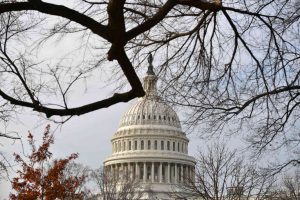DECEMBER 11, 2020

The US Capitol is seen in Washington, DC on December 7, 2020. – MANDEL NGAN, AFP via Getty Images
WASHINGTON, D.C. – The Senate unanimously passed a stopgap funding measure Friday to avoid a government shutdown for one week while lawmakers work to close a deal on government funding.
The bill, which keeps the government open at current funding levels, was already passed by the House earlier this week. It now heads to President Donald Trump for his expected signature.
The prospect of a government shutdown loomed Thursday evening as Sen. Rand Paul, R-Ky., threatened to hold up passage of the funding measure over his objections to provisions in a defense authorization bill. But by Friday morning, Paul lifted his objection, telling reporters on Capitol Hill he would allow the government funding measure to proceed.
Negotiations over a comprehensive government funding bill have stalled, with lawmakers unable to close the gap on several issues, including border wall funding and funding for detention beds for Immigration and Customs Enforcement.
Another stumbling block is Democrats’ attempt to incorporate language on police reform after a summer of protests over systemic racism and the killing of unarmed Black people, including George Floyd in Minneapolis.
Sen. Richard Shelby, R-Ala., the chairman of the Senate Appropriations Committee, told reporters Thursday that senators were close on a spending deal but “there are a few things out there” to resolve.
While both sides of the aisle have promised a deal, shutdowns haven’t been rare over the last several years. Since Trump took office, the government has shut down three times, including for 35 days in 2018 – the longest-ever shutdown in modern U.S. history. It stemmed from a standoff between Congress and the White House over funding for a wall along the southern U.S. border.
If Congress and the White House aren’t able to come to an agreement, thousands of government workers considered nonessential would again be furloughed or forced to work without pay until the shutdown ends, with ripple effects across the economy touching everything from agencies responding to the COVID-19 pandemic to air travel.
National parks may close, airport operations could slow and the paralysis could affect the economy, which has been battered by the coronavirus pandemic. The nonpartisan Congressional Budget Office estimated tax revenue was down $2 billion in 2019 because the IRS had halted some operations during the 2018 shutdown.
At the same time they try to close a deal on a spending bill, lawmakers have continued a monthslong-attempt to pass another COVID-19 relief bill. Congress hopes to approve potentially billions of dollars for critical programs and renew aid programs that have already lapsed or are set to expire after Christmas.
Some senators think the stimulus legislation could be included in a government funding deal, assuming deals on government funding and stimulus come together in time.
“The fact is, we’re not going to have a standalone COVID-19 bill. It will be part of the omnibus if it’s there at all,” Sen. John Cornyn, R-Texas, told reporters Wednesday, referring to a comprehensive spending bill. ” And so it’s probably not going to be as expansive as many of us would like.”
Despite months of negotiations, lawmakers have a short amount of time left to pass a deal before they leave for Christmas, and with competing proposals on Capitol Hill, it remains unclear if lawmakers will be able to come together on a compromise.
Democrats have staked their hopes on a bipartisan group of lawmakers who have continued meeting to negotiate a deal, but the group has not yet reached a final agreement on the language of their proposal. Senate Republican leaders and the White House, on the other hand, have pitched a new relief proposal that includes $600 stimulus payments but cuts a boost to federal unemployment benefits.
For months, the largest sticking points in negotiations have remained liability protections for businesses, a Republican priority, and aid for state and local governments, which Democrats want in any deal.
Courtesy/Source: This article originally appeared on USA TODAY










































































































